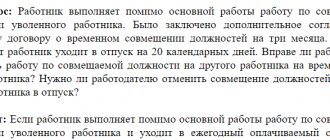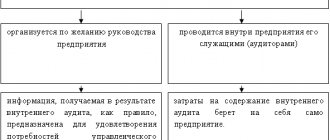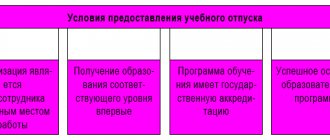What legal norms govern
When arranging leave for part-time workers, the employer should take into account the provisions of the Labor Code, as well as guarantees to employees regarding the provision of leave under a collective agreement.
The rules and key features of granting leave to part-time workers are contained in Art. 286 Labor Code. The duration of leave for part-time workers is contained in Art. 93 TK.
External and internal part-time workers can count on the following types of leave:
- Paid annually.
- Additional paid.
- Additional unpaid (administrative leave).
- Maternity leave.
https://youtu.be/zbXxKMMTtcU
What is part-time work
According to Art. 282 of the Labor Code, part-time work means that an employee performs other paid work under the terms of an employment contract in his free time from his main job.
According to Art. 60.1 of the Labor Code, part-time work means:
- Work under two employment contracts with one employer (the so-called “internal part-time worker”).
- Work under two employment contracts with different employers (the so-called “external part-time worker”).
According to Art. 282 of the Labor Code, employment contracts for part-time workers can be concluded with an unlimited number of employers, if this does not interfere with the performance of the employee’s job duties.
Is vacation allowed when working part-time?
Part-time workers are entitled to leave along with main employees. Annual leave for part-time work and the main place of work is provided to employees at the same time. The explanatory letter of Rostrud No. 1248-6-1 of 2009 indicates the position according to which vacation for part-time workers should coincide with vacation at the main place.
To comply with this rule in Art. 286 of the Labor Code provides the following algorithm:
- At the main place, the employee goes on vacation according to the vacation schedule.
- In a part-time job, the employer gives leave to his employee at his request.
A company where an employee works part-time cannot refuse to provide him with leave. In this case, the employer does not have the right to request additional documents confirming the employee’s right to leave.
But if desired, the employee can provide a certificate of leave from his main place, an extract from the leave schedule and a copy of the leave order. But without the specified documents, a part-time worker cannot be denied leave.
As for internal part-time workers, in this case the employer simply provides leave at the same time for both positions in which the employee is involved.
Duration of paid days of continuous rest
According to Russian legislation, the minimum period of paid leave each year is twenty-eight days. This period of time for rest should be provided both at the main place of work and at the additional one, despite the fact that in the second case the employee spends much less time in the organization.
Due to the fact that in all combined positions the vacation period must coincide, the discrepancy between these indicators can be compensated. Consider the following cases:
- In the main position, the employee is granted an extended type of leave, and in a combined position - the usual twenty-eight days (for example, for teachers). In this case, at the place of part-time work, at the employee’s request, he is required to provide him with additional days of rest as a period of unpaid leave. To receive these days, the employee must provide the employer with a certificate from his place of work about the vacation, a copy of the order or vacation schedule.
- At the main job, the employee has the right to receive a longer vacation in addition to the basic one (for example, people working in hazardous conditions, with children, disabled people). The same right remains with the employee during combination. Therefore, the employer is obliged to let him rest for the entire required time.
- At a part-time job, there is more vacation than at the main job. In this case, the employee can return to work when the shorter vacation ends. In this case, the unused rest period must be compensated financially by the employer.
Duration
Part-time workers are entitled to a standard leave of 28 calendar days. According to Art. 93 of the Labor Code, despite working part-time, leave for part-time workers is provided in full.
If an employee works as a part-time employee for less than six months and is going on vacation at his main place of work, then the part-time vacation is provided in advance. Based on this rule specified in Art. 122 of the Labor Code, we can conclude that the employer does not have the right to require a part-time worker to work for six months before going on vacation.
External and internal part-time workers can count on extended paid leave if it is guaranteed to them by law. In particular, the following can count on such leave:
- Teaching staff (according to Article 334 of the Labor Code and Government Decree No. 466 of 2020).
- Medical workers who diagnose and treat HIV-infected people according to clause 4 of Government Decree No. 391 of 1996.
Additional leave may be provided to employees who are involved in work with harmful and dangerous working conditions, work in the Far North, or have a special nature of work.
If an employee at his main place of work is granted leave of a longer duration than part-time, then, at the employee’s request, additional days of leave can be provided to him without preserving earnings (under Article 286 of the Labor Code).
This situation is rare in practice: for example, if the employee’s main job is a teacher, and part-time he is a sales manager.
In this case, a longer vacation must be confirmed by a certificate from the main place of work or an extract from the vacation schedule from the main place. The specified document is provided at the place of employment.
Registration of vacations for part-time workers
Since vacations are provided to employees according to a schedule approved two weeks before the end of the current year, rest days for persons combining two positions are recorded as follows:
- If the main vacation period is known, this time is indicated in the schedule at the additional place of work.
- If the start date of rest from the main job is unknown, an empty space marked “part-time worker” remains in the schedule of the person combining two positions.
- Part-time employees of the internal type are indicated in two vacation sheets, but with one period of time.
Part-time leave must be granted to the employee on the same days as for the main job. If the periods of rest days do not coincide in duration, the issue must be resolved by agreement with the employer.
Your rating of the article
How to apply
The procedure for granting leave to part-time workers is as follows:
- The part-time worker's vacation is included in the vacation schedule , which is approved by management annually.
- The employer informs the employee about the upcoming vacation at least 2 weeks before it starts, against his signature, according to Art. 123 TK.
- An order is drawn up in form T-6 . In the leave order, the employer must indicate the full name, position and personnel number of the part-time worker, duration, start and end dates of the leave.
- The order is transmitted to the accounting department , which, based on it, must accrue vacation pay to the employee.
- At least three days before the vacation, the employee is paid vacation pay under Art. 136 TK.
- Information about leave is entered into the employee’s personal card in form T-2 . The card specifies the vacation dates and order details. It is also worth familiarizing the employee with the recording against his signature.
According to Art. 123 of the Labor Code, when working in a part-time company, a vacation schedule is also approved for him. When drawing up a vacation schedule for the next year in relation to a part-time worker, the employer should do the following:
- If an employee does not know when he will be given leave at his main place, then his leave is not displayed in the vacation schedule . In the notes column, you just need to note that the employee works for the company as a part-time employee.
- If the part-time worker knows when he goes on vacation at his main place, then these same dates are displayed in the vacation schedule.
With regard to personnel documents accompanying leave, it must be taken into account that they are filled out as usual.
To issue an order for leave for an internal part-time worker, you must separately indicate leave for his main place of work and part-time work (despite the fact that this will be the same period). For these purposes, you can use form T-6a, which is used to issue an order in relation to several people. In the table you will need to indicate the same full name of the employee on different lines, and the differences will be contained in the column with position, personnel number and structural unit.
A sample application for leave for a part-time worker can be downloaded from the link.
If the part-time employee’s vacation was recorded in the schedule, then the employee does not need to write an additional vacation application. An application is required if a part-time worker would like to reschedule vacation dates if the vacation was not indicated in the schedule (when the employee did not have information about the vacation dates at the main place when drawing up the schedule or the employee goes on administrative leave).
What does the law say?
Leave for a part-time worker is issued in accordance with all the rules of the Labor Code, because he is the same employee, even if he does not work full time.
Since an employment contract with part-time workers must be concluded, then guarantees must be provided to them.
But is it fully? In theory, since a part-time worker does not work his wages, he should rest in proportion to the amount of work he has worked. But this is not at all true from the position of Rostrud, judicial practice and the Labor Code.
It is worth noting that our logic does not always coincide with the logic of legislators. It is for this reason that we first study the laws and then turn on logic.
Legislators allow you to work for several bosses, as long as it does not affect the results of your work.
And in every organization, a personal file is opened for each employee, the main document of which is the employment contract. That is, how many works - so many contracts.
Additional work can be assigned both at the main place and in another company.
An internal part-time worker is an employee “sitting on two chairs,” or rather, two workplaces in one company. He has one boss, but two jobs, and he combines different staff positions. Part-time work is called internal, since two jobs are combined within one organization.
Registration of an internal part-time worker
An external part-time worker works outside the scope of his main job, in another organization. Where they also open a personal file on him, sign an agreement and assign him a personnel number.
Regardless of whether the part-time worker is external or internal, he is entitled to all labor guarantees.
Article 286 of the Labor Code obliges directors to allow part-time workers to rest during the same period specified in the vacation schedule for their main job.
Even if an employee has not worked part-time for even six months, he should still be given leave - in advance.
At the same time, if the vacation at the main place is longer than here, then, upon his application, you are obliged to place him on administrative leave for the remaining period.
Vacation dates
A nuance: if, on the contrary, a part-time worker has a longer vacation than at his main job, no one is obliged to extend it!
According to Article 123 of the Labor Code, it does not matter whether the employee has a main job or a part-time job, his vacation must be according to the approved schedule.
And you need to warn him no later than two weeks before this deadline.
If the part-time worker is our own, that is, internal, then everything is simple - in the schedule we mark the same period as his main employee. What about an external part-time worker?
When applying for employment, the law does not oblige the employee to request a certificate or a vacation schedule from his main job. At the same time, the director obliges the director to release him at the same time as the main employer.
- vacation certificate;
- extract from the vacation schedule;
- a copy of the leave order.
However, without these documents it is still impossible to refuse leave to a part-time worker.
Leave from main job is longer
A nuance: if the vacation at your main job is longer, and you have given your part-time employee administrative leave, do not enter this period into the vacation schedule; it will be reflected in the timesheet.
Yes, it happens that the main place is vacation time, but the part-time employee continues to work. Is it really possible for vacation times at different jobs to not coincide?
Rostrud, by letter No. 1248-6-1 dated September 08, 2009, clarified that a part-time worker’s vacation must coincide with his vacation at his main job. This is motivated by the fact that the part-time worker loses the chance to fully relax.
However, there is such judicial practice when a judge recognizes part-time leave as legal without linking it to the main job.
In Russia, the requirements of the law are treated as follows: if it is not prohibited, then it is permitted. And since a direct ban on working during vacation is not enshrined anywhere, then the last word remains with the employee and the director - as they agree, so it will be.
We arrange a vacation
Since the Labor Code forces you to give two weeks notice about a vacation, we will notify you.
We write the text of the notification “I notify you that according to the vacation schedule, your annual paid vacation lasts 14 calendar days, and its period begins on February 04, 2020.
, and ends on February 18, 2020.”
The part-time worker must leave an autograph and a number on the notification.
We serve the notice
Note: the notice can be given at any time, even the next day after the vacation schedule is approved. The main thing is no later than two weeks before your vacation!
The next step will be a leave order for a part-time worker, a sample of which is here. Its required details:
- Full name, position and personnel number of the part-time worker;
- the period of work for which leave is granted;
- duration;
- start and end date.
Read the order
A nuance: we familiarize you with the order no later than three days in advance, because a copy of it, along with the calculation note, must be given to the accounting department for accrual of vacation pay.
Important: in the report card, vacation is usually designated “FROM”; code “B” denotes holidays that fall on vacation. If the vacation is followed by an administrative one at the request of a part-time worker, the report card will already contain Fr.
We issue a T-2 card:
- We enter the vacation period and order details;
- write down the period of work for which rest is provided;
- We introduce you to the employee's record.
When to put a part-time worker’s vacation on the card
A nuance: you can add a part-time vacation to the card even after the part-time person takes time off and suddenly gets sick, then you will need to redo everything.
And don’t forget to put a copy of the order in your personal file!
The Labor Code of the Russian Federation allows employees to perform other duties during the time not occupied by their main work, if they do not contradict their qualifications. This possibility is regulated in Chapter 44 of the Labor Code of the Russian Federation.
In particular, the text of the Labor Code of the Russian Federation contains a mandatory requirement for employers to consolidate relations with a part-time worker in an employment contract, which will also include a clause regarding timely departure for the next vacation.
Payment for part-time work is carried out in accordance with the regulations of Art. 285 of the Labor Code of the Russian Federation, the eligibility of going on “part-time” leave is noted in Art. 286, and the issues of vacation payments are regulated by Chapter 19 of the Labor Code of the Russian Federation, which considers the issues of vacations for any form of employment.
There are two types of part-time work – internal and external. At their core, they are the same. Leave from part-time work and the main place of work is a right for any employee. It is enshrined in the employment contract. But how can the employee himself take advantage of this right within the framework of current legislation?
We suggest you read: How to pay for internal part-time work
Regardless of whether a person is an internal or external part-time worker, the allotted rest time at his main job must coincide with the dates when he is entitled to leave when working part-time in another organization. The employee's procedure is slightly different, depending on the type of part-time job.
Payment for basic vacation
The amount of vacation pay that is due to a part-time worker is determined according to the general rules specified in Art. 139 of the Labor Code and clause 10 of Regulation No. 922 of 2007. To determine the amount of vacation pay, you need to determine the average salary of a part-time employee.
The duration of paid leave is determined in calendar days ; holidays and non-working days are not included in the calculations. Vacation pay has no maximum limit.
The calculations take into account all the employee’s income for the billing period, which is guaranteed to him according to the remuneration system (bonuses, salary, etc.). In this case, the amounts of accrued sick leave and benefits are deducted from the calculations.
For internal part-time work, the same algorithm is used. That is, the employee, in fact, receives two vacation payments: one at his main place of work, the second at his part-time job (according to his position).
Upon dismissal, a part-time employee can count on receiving compensation for unused vacation on the basis of Art. 127 TK. But to do this, he must work for the specified employer for at least 2 weeks. The amount of compensation is calculated according to the general rules: in the amount of the average daily earnings of a part-time worker for each day of unused vacation. The fact of payment of compensation does not depend on the grounds for dismissal.
If a part-time worker took a vacation in advance, then the overpayment is withheld from his earnings under Art. 137 TK.
Vacation pay calculator
For a detailed calculation of vacation pay, follow the link.
Vacation pay for part-time workers
Leave for all categories of employees (at their main and additional places of work) is paid according to the norms of the same articles of the Labor Code. The accrued amount is calculated based on the average salary of the employee.
In this regard, despite the same number of days of rest, their payment will be different. This is due to the fact that part-time employees have fewer hours to work.
If vacation was provided and paid to the employee in advance to equalize the days of rest at both places of employment, in the event of early dismissal, this money will be forcibly recovered from the employee.
The payment terms for vacation pay at the main and additional places of work are the same - three days before the start of the rest period.
Payment for maternity leave
Maternity leave can be taken part-time. To do this, the employee must take leave from her main place of work, and then from her part-time job. Both employers should provide original sick leave certificates.
Maternity payments are transferred to the employee by all organizations in which she was employed. But this requires that she work in these places for at least 2 years. But this rule applies only to maternity benefits: an employee applies for child care benefits up to 1.5 years only for one place of work. She has the right to make a choice independently, but usually the benefit is issued at the main place of work, since the employee’s income is higher there.
If a woman has worked for several employers over the past 2 years and changed jobs, then one of the employers (at her last place of work) will pay her maternity benefits.
If over the past 2 years a woman has worked for both current and previous employers, then she has a choice as to who will pay her maternity benefits.
Maternity benefits are calculated on a general basis . Initially, the woman’s average daily earnings for the previous 2 years are determined. This value is then multiplied by the number of days of maternity leave. The duration of maternity leave depends on the nature and characteristics of the pregnancy: by default it is 140 days for a normal singleton pregnancy.
When calculating maternity payments, limits are taken into account: the average daily earnings received cannot be less than calculated on the basis of the minimum wage and more than calculated based on earnings in excess of the income limit from which contributions to the Social Insurance Fund are paid. These limits are regularly reviewed.
Maternity leave calculator
| Vacation period (140-194 days) |
| Estimated years: |
YEAR
YEAR
| Regional coefficient, % | Less than 6 months experience |
| Average daily earnings |
Total benefit amount:
Leave at the main place of work and part-time work: internal and external
The labor legislation of the Russian Federation provides for the opportunity for every working citizen to obtain a part-time position, that is, to simultaneously work in two jobs.
Traditionally, in practice, when calculating vacation pay, unforeseen difficulties may arise, since the employer and the HR specialist have to take into account the possibility of coincidence of time at both jobs - the main and additional jobs.
Part-time work is a workplace of an additional nature. A part-time worker spends less time at the relevant workplace than at his main one.
On the part of the employee, such activities can be carried out within one company (called internal part-time work), and can also be carried out at different enterprises (called external part-time work).
Article 286 of the Labor Code of the Russian Federation stipulates vacation when working part-time. It regulates the issues of calculating rest days for employees working in two places, taking into account the subtleties in the form of length of service, the specifics of the activity and the wishes of the employees.
However, when receiving leave, a part-time worker may experience difficulties caused by two factors:
- Determining the duration of periods due to the complexities of the legal framework
- Problems of coordinating vacation time between positions.
There are several basic provisions regulating the rules for internal and external part-time work, within the framework of which contractual relations are drawn up and the details of vacations are negotiated:
- If the duration of the main rest is longer than the duration of the period regulated for part-time work (if there is more leave at the main place of work than for part-time work), the manager is assigned the main responsibility - to provide the employee with time off at his own expense. No refusal by the employer is unlawful.
- If the base period does not exceed the number of days expected to work part-time, unused resources are formed - days of rest. The employer undertakes to compensate them in full and pay money. The situation has not been considered within the framework of legislative acts due to its rare occurrence.
- If, at the time of receipt, the employee did not manage to work the required amount of time in the organization, he receives vacation as an advance and may well qualify for full payment of vacation pay.
- Employees going on maternity leave can combine two vacations, but payments are calculated only for one workplace, which is determined directly by the employee. You can choose either your main place of work or an additional one.
If there is internal combination, then there are no problems when registering vacations for employers, and each employee receives vacation payments and days on the basis of current legislation.
If leave is being considered at the main place of work and part-time work in another organization, then the employee is required to write an application for the places of main and additional part-time work.
It is necessary to draw up not only an application for leave, but also to attach evidence and facts to it in the form of a copy of the order drawn up at the main place.
The countdown is carried out from the first day until the last day of vacation, which are noted in the relevant Order. If you have a vacation in one place, there is no obligation to visit another place. Absence from work for these reasons is not considered absenteeism.
The procedure in which vacation days and corresponding payments are provided is established on an individual basis and depends on a number of contributing factors - the desires of the employee, the capabilities of the organization.
Thus, there are several situations of combined provision of leave, and the main task of employers is to act on the basis of the law, without infringing on the rights of ordinary employees, negotiating with them the smallest details of the provision of days off and related benefits.
Registration for each place of work occurs in the same way as for the main job
Payments made at an additional place of work are always less than the funds received by an employee at the main position.
This is due to the fact that the accounting department of an enterprise where the employee is a part-time employee only records the time actually worked.
The minimum duration of such a vacation period is at least 28 days, the actual duration is determined by the position held by the employee and the duties that he performs. For example, representatives of the teaching profession can count on 56 days of rest daily.
When drawing up vacation documents, benefits are taken into account. For example, these include various bonuses issued for work in certain conditions that cause harm to health.
Each enterprise has its own vacation schedule, which is negotiated with employees.
Immediately after drawing up the schedule in the personnel department, a representative of a higher position should familiarize his subordinate employees with the features of the new schedule.
The individual duration is established based on an agreement between the employee and the enterprise. But the main requirement for the period is that it does not go beyond the approved schedule.
https://youtu.be/OfbIVGnxNQw
If an employee wishes to go on vacation during a period not specified in the schedule, he must write a statement with the following content:
- addressing the manager by full name and indicating his position;
- a note with the full name of the employee writing the application;
- request for leave for a certain period;
- the date when this document was compiled.
Based on the completed application, management subsequently creates an order indicating the start of the vacation period and its duration.
Then the accounting department calculates vacation pay for the part-time employee for all groups of payments.
The employer undertakes to pay all funds within 3 days before the vacation period begins.
The minimum duration of such vacation period is at least 28 days
So, we have looked at how to properly arrange internal part-time leave, and there should not be any problems with this point.
However, in other cases of practice, difficulties often arise that are important to foresee in order to avoid unforeseen circumstances in the future.
It has already been said that employers at an additional place of work can claim confirmation from the employee of the fact that he receives leave from his main place of business.
Within the framework of labor legislation, employees do not have a corresponding obligation, however, if management insists, the employee can provide a copy of the order from the main place of work.
Thus, there are several circumstances that influence the provision of leave, in particular, this includes part-time work with parental leave for fathers and mothers.
It reflects the duration of the rest period for employees, as well as the conditions for providing rest days for employees.
We invite you to familiarize yourself with: Sample order to change the number of vacation days
The rules for calculating vacation are prescribed in Article 120 of the Labor Code of the Russian Federation:
- the time of paid leave (main and additional) is calculated in calendar days;
- Holidays and non-working days are not included in the total number of vacation days;
- to calculate the total period of paid annual leave, you need to sum up additional leaves with the annual basic leave;
- Vacation is not limited to a maximum limit.
The number of vacation days entitled to an employee in his main job and the number of days of vacation in a part-time job may not coincide. This applies to leaves when working part-time in another organization. If in a part-time job the annual paid leave turns out to be shorter than in the main job, then the employer, at the request of the part-time worker, must extend his leave. In this case, wages will not be maintained for an exceeding period (Part 2 of Article 286 of the Labor Code of the Russian Federation).
As a rule, there are no difficulties in calculating leave for an internal part-time worker. After all, his main workplace and part-time job are in the same company, where uniform rules are established.
If the employee is an external part-time worker, then at his main place of work he goes to rest in accordance with a schedule drawn up in advance. In a related job, the head of the organization is obliged to provide leave to an external part-time worker for the same period. The basis will be the statement of the employee.
The employer does not have the right to require a certificate of vacation periods at the main job. He can only ask to do this, but not oblige. If the employee refuses, leave will still have to be provided.










